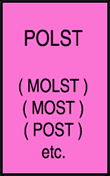
SERIOUS ILLNESS: Palliative Care | Hospice Care | POLST Form | Coping With Illness | Informed Decisions | Peace & Grace
What is a POLST Form?
 POLST stands for: Physician Orders For Life-Sustaining Treatment
POLST stands for: Physician Orders For Life-Sustaining Treatment
This form may go by the names of MOLST , MOST, POST etc. in different states in the US. The purposes of the form, no matter what it is named, is to let emergency personnel know whether or not you authorize receiving the full measure of high-intensity, life- saving measures, or some measure of treatments and/or comfort focused care.
A POLST is a stand alone form that is part of overall Advance Care Planning. While it may be filled out at any time, generally its first use begins when you have a diagnosis of a serious illness or a condition such a frailty.
When Do You Need to Create a POLST Form?
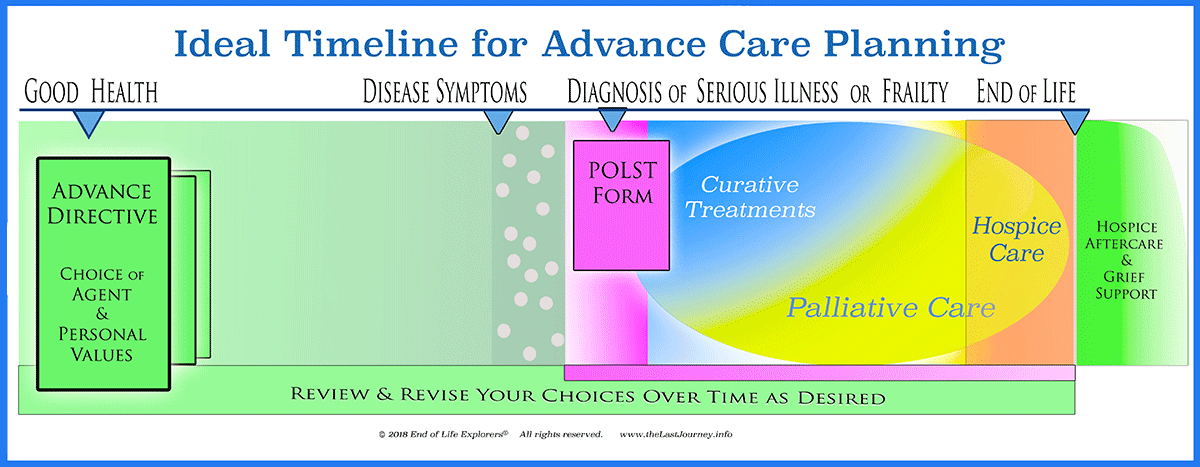
The Right Paperwork for Your End of Life Wishes
by Jessica Nutik-Zitter, MD – New Your Times
Read the article
POLST in Action:
To learn some of the choices that are made on a POLST form, watch these video conversations between doctors and patients.
POLST: Doing it Better
Treatment choices made by an older adult with cancer.
Making POLST Choices Over Time
A woman and her daughter discusses POLST choices with medical personnel before and after she has surgery.
Treatment choices for a young woman with cancer.
See also Why POLST – a helpful video in Spanish
Frequently Asked Questions
Massachusetts uses the term MOLST (Medical Orders for Life-Sustaining Treatment – same form as POLST by a different name) and has a very helpful information page on their MOSLT website. Their FAQ section gives you answers to questions that apply to most situations where these forms may be used.
Find answers on their website
POLST Organizations
Oregon, Washington, California, Massachusetts lead the nation in actively developing the use of the POLST form.Take time to understand how and when to use this valuable form. Learn about the nationwide effort to make our personal end of life care choices known and easily accessible via the POLST form.
National POLST Paradigm
In depth information about the national effort to help people identify their personal choices in a medical emergency situation.
Learn more
POLST California
Guides, Videos, and FAQ regarding POLST
Learn more
Your POLST choices may change
As a serious illness progresses, you and your doctor will need to review your choices on your POLST forma and see that they are still the choices you want to make. Emergency medical situations may arise and resolve and arise again as a person nears the end of a serious disease and life. More frequent reviews may be appropriate at that time.
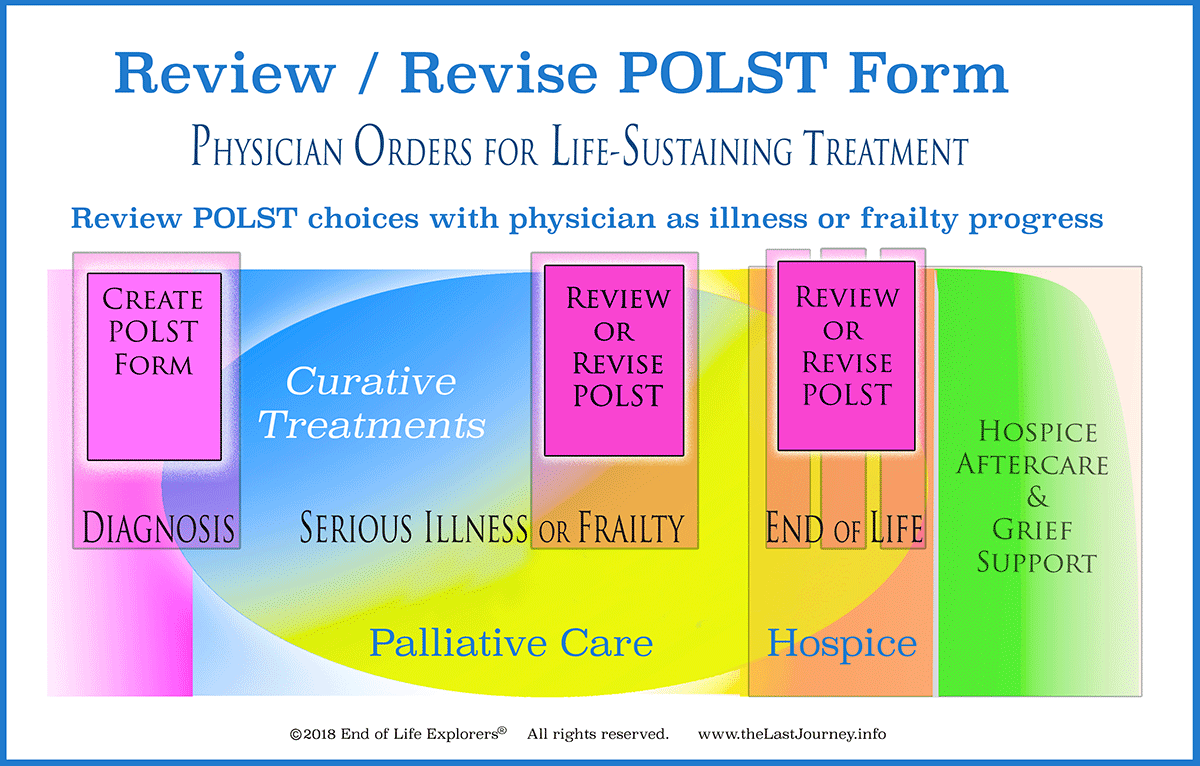
Who needs a copy? Everyone !
You, your Agent, your doctor, your loved ones, the director of any facility where you live, Emergency Medical Technicians that treat you or transport you, hospital emergency or ICU units, rehabilitation, assisted living or skilled nursing centers where you might stay – everyone.
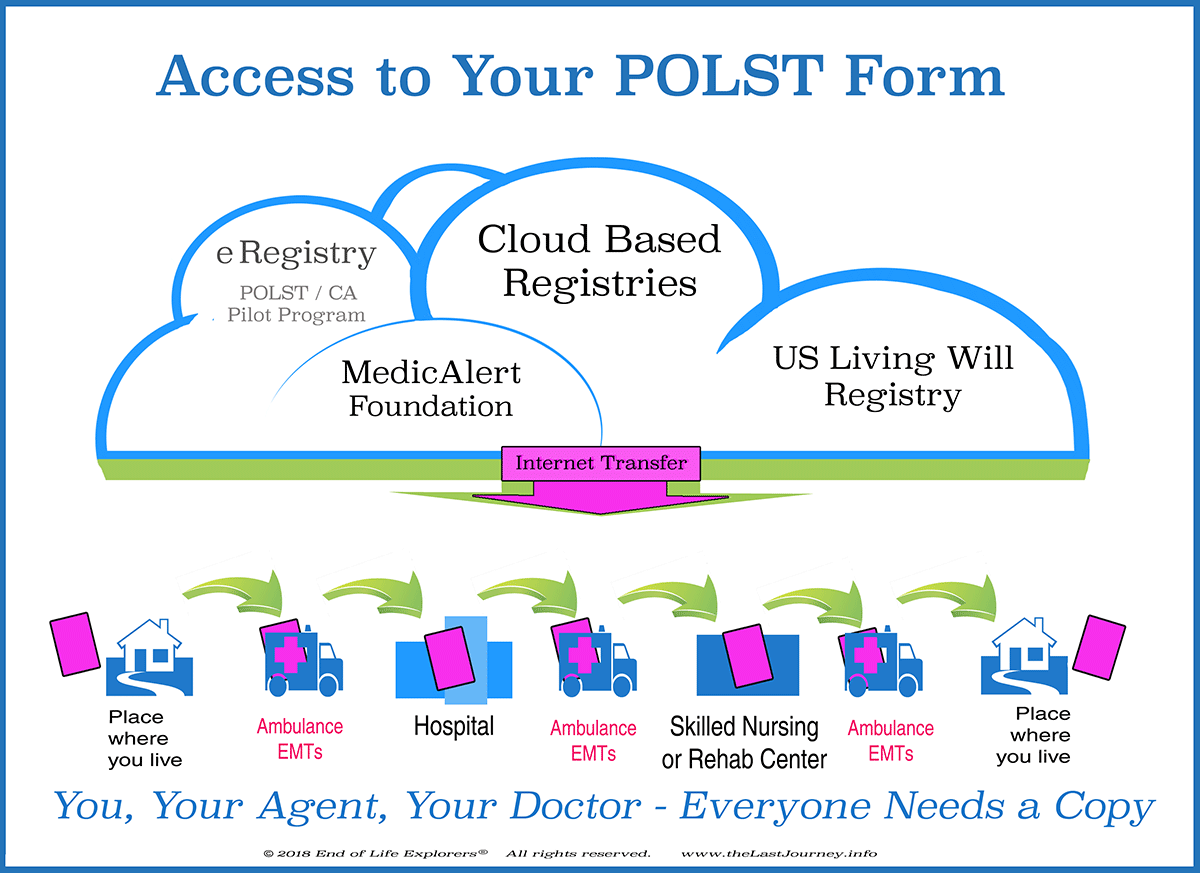
In Any Medical Emergency
Your POLST form & your Advance Directive need to be readily available
The concept and intent of the POLST form (and the forms of similar name in other states) is to have one easy-to recognize, easy-to-locate, and easy-to-transport form stating your choices for end of life care that can be accessed rapidly and respected consistently in a life-threatening, emergency situation. Ask your Agent to bring a copy of you most recently signed and dated Advance Directive with them to any Urgent Care or Emergency Room where they will be asked to speak for you if you are not able to speak for yourself.
California POLST Registry Pilot Program
A program is in development in California to provide a means of having POLST form automatically registered in an online service so that the choice an individuals makes on his or her POLST form are immediately accessible to all health providers during a medical emergency.
Learn more
If you are not able to speak for yourself….
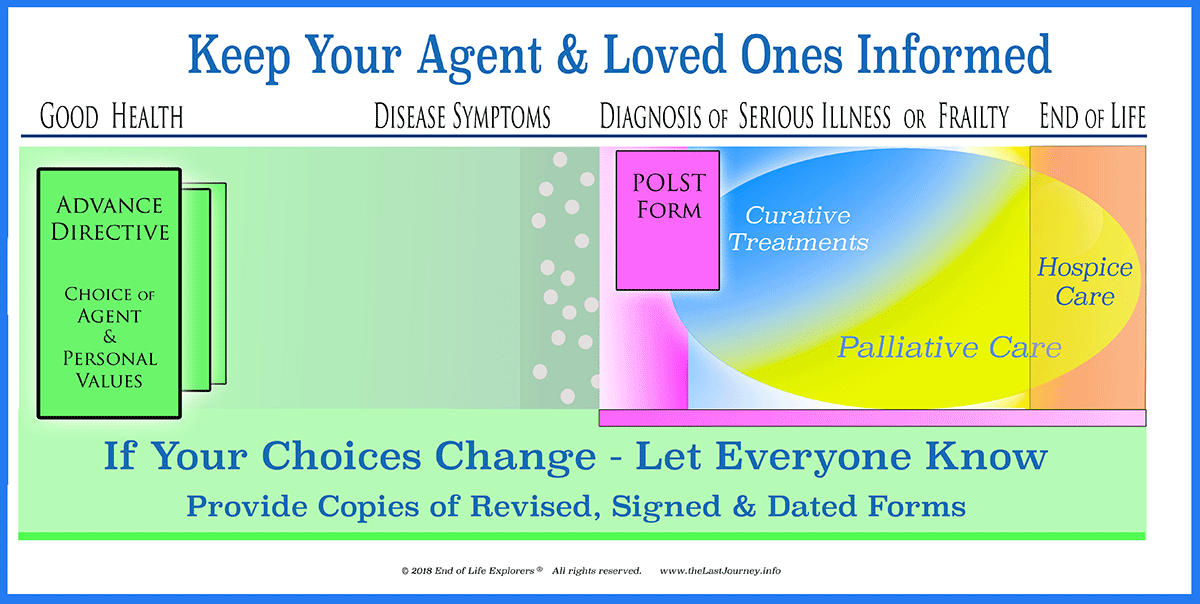
Two Important facts to know:
A copy of your signed & dated POLST form on plain white paper is as valid as any POLST (MOST, MOLST, POST ) form on brightly colored paper. The bright paper simply makes it easier to locate.
A copy of your signed and dated Advance Directive is as valid as the original.
5 Things You Can Do Ahead of an Emergency
Understanding “Full Code” or “Full Treatment”
A “code” in medical jargon is a quick way of describing a set of prescribed medical treatments and actions are performed in a particular medical emergency situation. Different colors are assigned different codes to make it easy for medical staff to recognize the type of emergency and to respond quickly and appropriately. A Code Blue indicates an adult medical emergency situation. You might also hear someone say “the patient is coding” as an alert to medical staff to start specific life-sustaining actions.
If a person’s heart stops beating and she or he is no longer breathing, it is considered that they have died a natural death. Unless the patient has chosen No CPR / DNR or Do Not Resuscitate on a POLST form, she or he will be given Cardiopulmonary Resuscitation (CPR) to attempt to start the heart again and restore breathing. If the CPR is successful, he or she will be transported to an Intensive Care Unit in and ambulance and will almost certainly have a full range of life-sustaining treatments initiated.
Important to understand: In the first section of the POLST form, If you have indicated that you do want to have CPR attempted to re-start your heart – you must also choose Full Treatment in second section.
Life-sustaining treatments can be initiated and later withdrawn with the consent of the patient if he or she is conscious and has the capacity to make decisions, or by the patient’s Agent if one has been designated. This is one of the many reasons that communicating your wishes ahead of such an emergency and choosing and communication withour Agent and your physician is so important.
Watch this video to learn about the “full code” interventions used in a life-threatening emergency in an Intensive Care Unit
DNR Code Status Explained Clearly
Watch the award winning documentary Extremis on Netflix to see a “full code” of medical interventions used in an ICU.
Life-Sustaining Measures in Intensive Care
Cardiopulmonary Resuscitation ( CPR )
CPR: Your Chances of Survival are Better on TV
Surprising information on chances of survival after having Cardio-Pulmonary Resuscitation in real life versus what is depicted in TV series.
Read the article
Ethical Concerns in Cardiopulmonary Resuscitation
by Samuel D. Hensley
The Center for Bioethics and Human Dignity
Read the article
Mechanical Ventilator – Cleveland Clinic
Learn about this medical procedure
Artificial Nutrition and Hydration
Statement by the American Academy of Hospice and Palliative Medicine
Learn about this medical procedure
Pre-Hospital DNR Directive
for Emergency Medical Technicians ( EMTs )
What is a DNR Directive?
It is a form that stands on it’s own and is not part of an Advance Directive or a POLST form although it is sometimes used in combination with a POLST form. .
A common title is: Emergency Medical Services Pre-Hospital Do Not Resuscitate (DNR) form. Regulations may vary in different states. Generally this form allows a person to specifically request to limit the emergency medical care received from EMTs or other emergency personnel before being sent to a hospital.
A DNR Directive is used when a person absolutely does NOT want any procedure to restart their heart or restore their breathing. It focuses solely on Cardiopulmonary Resuscitation ( CPR) and does not address the other situations or treatments covered in a POLST. It is a form that needs to be discussed with a primary care doctor.
Both patient and physician must sign this form for it to be valid. Signing the form does not prevent receiving other forms of medical care and comfort measures prior to death. The form can be revoked at any time.
If you and your primary care doctor sign this form, ask your doctor to electronically scan this form into your medical records. You keep a copy with your DNR Directive form. Give a copy to your health care decision maker, and to the director of an assisted living or skilled nursing facility if applicable.
DNR Medallion or Bracelet
Why wear a DNR medallion or bracelet?
Emergency personnel are trained to look for a medical medallion or bracelet. It can alerts them that you do not want life-sustaining treatments. In general, ordering a medical medallion or bracelet requires a signed form from your primary care doctor before you can order one.
A DNR/POLST medallion or bracelet is available in several formats and can be ordered from this non- profit organization. It requires a doctor’s signature on a form available in his or her office.
American Medical ID
A supplier of Medical ID bracelets has links to state-specific regulations on the use of medical ID medallions. It is important to investigate what is accepted practice in your state.
Learn more
Valid DNR or POLST medallions or bracelet are available in several formats and can be ordered from this non-profit organization. It requires a doctor’s signature on a form available in his or her office.
MedicAlert Foundation
DNH – Do Not Hospitalize ( Do Not Transfer to Hospital)
A doctor and his patient discuss his preference not to be sent to the hospital in a medical emergency.
